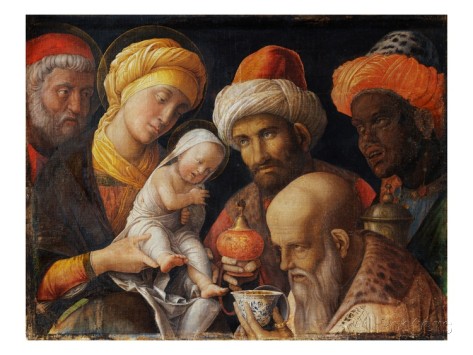“We Three Kings”, is a Christmas carol whose lyrics and music were written by John Henry Hopkins, Jr. in 1857.
(Here you can find lyrics and video)
At the time Hopkins was an ordained deacon in the Episcopal Church, and while serving as music director of the General Theological Seminary in New York City he composed this carol for a Christmas pageant.
The song, which is arranged in such a way that three male voices (the three kings) sing a single verse describing the gift they are bringing, has many of the characteristics of a Christmas carol including a refrain and a narrative-ballad style. It was the first Christmas carol originating from the United States to achieve widespread popularity.
It tells the story of the Magi (found in Chapter 2 of the Gospel of Matthew, the only one of the four Canonical gospels to mention them) who are travelling to visit child Jesus, guided by “a bright star”.
According to Matthew, who does not refer to them as “wise men” or “kings”, they came “from the east” to worship the “king of the Jews” led by the Star of Bethlehem which stopped “over the place where the child was”. Here “they saw the child with his mother Mary, and they bowed down and worshiped him”.
The account does not mention their number, but their gifts gave rise to the widespread assumption that they were three. “Then they opened their treasures and presented him with gifts of gold, frankincense and myrrh.”
The Magi are commonly known as:
Melchior a Persian scholar,
Gaspar (also called “Caspar” or “Jaspar”) an Indian scholar,
Balthazar a scholar from Arabia (or sometimes Ethiopia).
Their gifts are the usual offerings given to a king: gold as a precious tribute to royalty, myrrh, a common anointing oil, and frankincense, a perfume burned for religious ceremonies.
These three gifts had symbolic meanings: gold was a symbol of kingship on earth, frankincense was a symbol of deity, and myrrh (used in embalming processes) a symbol of death.
The refrain focuses on the beauty of the Star of Bethlehem, whose imagery is central to the Epiphany season and the narrative, and invites us to join the Magi in following its light: “guide us to thy perfect light.”
Image: Andrea Mantegna – Adoration of the Magi (1497-1500)

I love the symbolism of the three gifts – “King and God and Sacrifice.” Whether the Magi knew it or not, they were pointing to the uniqueness of Jesus. In Judaism, kings came from the tribe of Judah, and priests from the tribe of Levi. For Jesus to be both Priest and King was more significant than we 21st century Gentiles know. But then, being both God and man is even more significant and unique. Offering incense and worship to a man (or child) was downright shocking!
LikeLiked by 3 people
Thank you so much, I’m glad you stopped by! Your comment is really valuable and thought-provoking
LikeLiked by 1 person
Molto interessante come sempre e devo dire che mi sono sempre chiesta perché la mirra! Certo un olio profumato, ma con un significato doloroso per omaggiare una nascita! Forse una anticipazione del futuro? Bravissima come sempre!❤️🌺
LikeLiked by 2 people
Sì, è anche un presagio, a mio parere
Buon pomeriggio, cara Matilde: fra poco passo a farti visita. 🌹💖🌹💖🌹
LikeLiked by 1 person
Buon pomeriggio anche a te carissima!❤️e grazie
LikeLiked by 1 person
Wonderful post, Luisa. I also enjoyed reading the information left by your first commenter.
LikeLiked by 1 person
Thanks so much dear Pat.
I am really pleased to know that you enjoyed the post and that interesting and valued comment.
Sending love and best wishes 💗⭐️.
LikeLiked by 1 person
Same to you, my friend.
LikeLiked by 1 person
molto interessante la parte relativa ai doni e al loro simbolismo.
Sereno pomeriggio
LikeLiked by 1 person
Grazie! Mi fa proprio piacere sapere che hai trovato il post di tuo gradimento 🙏💜🙏
LikeLiked by 1 person
certe notizie non le conoscevo.
LikeLiked by 2 people
🙏😘🙏😘🙏😘🙏
LikeLiked by 2 people
😀
LikeLiked by 2 people
Wonderful post.
Loved reading it 🥰
LikeLiked by 1 person
You are really kind!
Thank you for your feedback and your support😘😘😘
LikeLiked by 1 person
🥰 Stay safe
LikeLiked by 2 people